The Hisense U8Q is a television that makes it hard not to feel that the manufacturer approached the topic with the ambition of a top student. The picture is strong, vibrant and contrasting – as if it were shouting: “look, I can do more than most in this price range!” And indeed, there is some truth to this. The secret lies in the large number of dimming zones in Mini-LED technology. Thanks to this, HDR does not just come down to promises in the brochure, but can actually impress – especially during evening viewings. It's also hard to complain about motion fluidity. Watching matches and fast-paced games is enjoyable, and although the ball may sometimes leave a slight trace, for 99% of viewers this will be a detail of little importance in everyday watching. Gamers also have reasons to be pleased here – although it's worth mentioning the lack of HGiG functionality right away. Aside from that, however, it is really good: low input lag, three HDMI 2.1 ports and a full set of gaming features make the U8Q one of the more interesting Mini-LEDs for console fans. Of course, there are no perfect products. The television still carries some “mini-LED” remnants, and the Vidaa system – although full of features – can be less intuitive and has a more modest selection of apps than competing platforms. But are these serious drawbacks or rather minor jabs in the context of the price and what we actually get? We leave the answer to that question to you!
- Matching (Score)
- Our verdict
- TV appearance
- Where to buy
- Contrast and black detail
- HDR effect quality
- Factory color reproduction
- Color reproduction after calibration
- Smoothness of tonal transitions
- Image scaling and smoothness of tonal transitions
- Blur and motion smoothness
- Console compatibility and gaming features
- Input lag
- Compatibility with PC
- Viewing angles
- TV efficiency during daytime
- Details about the matrix
- TV features
- Apps
- Playing files from USB
- Sound
Hisense U8Q vs Philips OLED770
Direct compare
U8Q
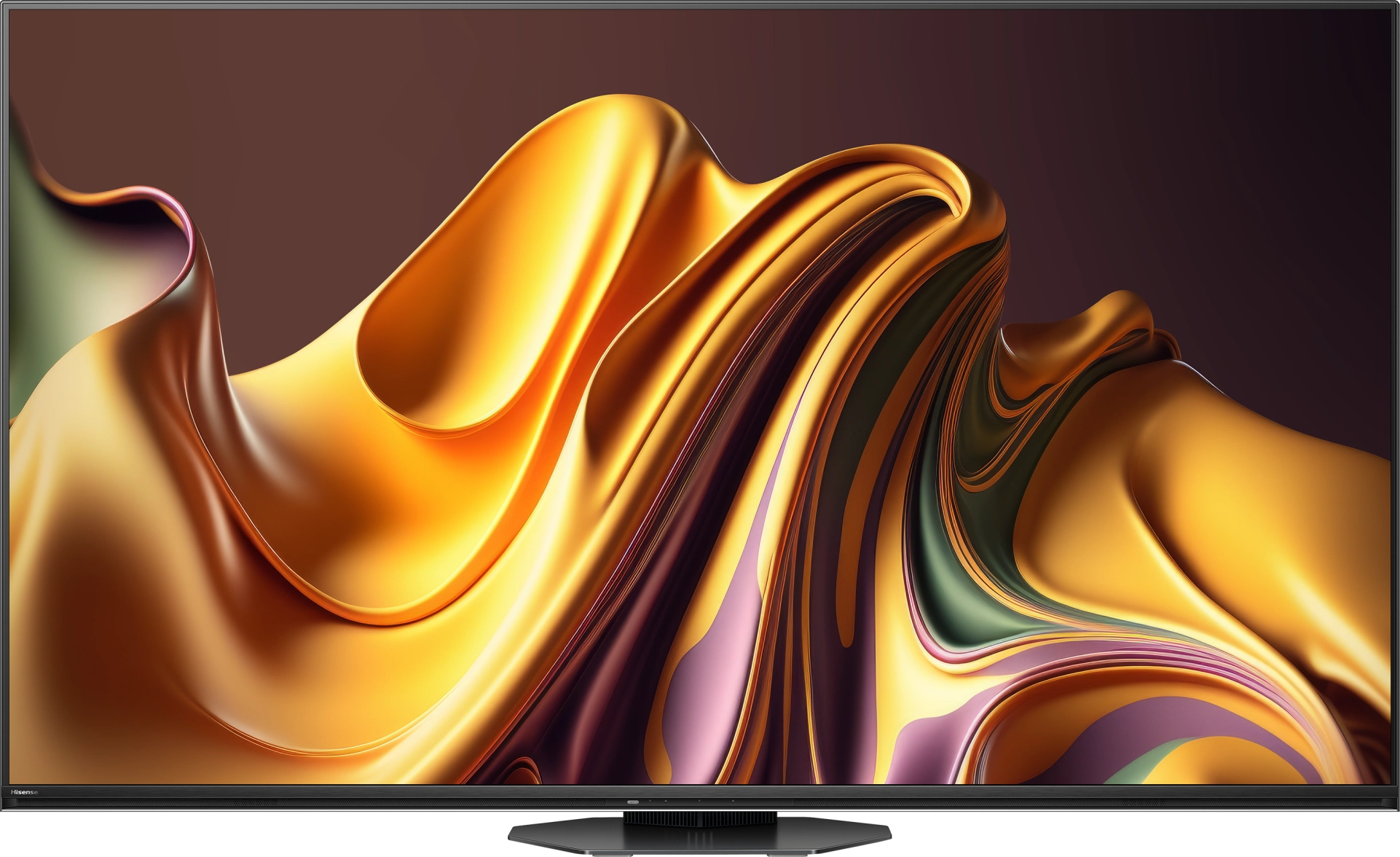

Panel type: LCD VA
Resolution: 3840x2160
System: VIDAA
Model year: 2025
Complete the survey to find out the result

Panel type: WRGB OLED
Resolution: 3840x2160
System: Titan OS
Model year: 2025
Complete the survey to find out the result

Overall rating
8.0
7.5
Movies and series in UHD quality
7.8
8.0
Classic TV, YouTube
7.6
8.6
Sports broadcasts (TV and apps)
7.2
8.4
Gaming on console
8.6
9.2
TV as a computer monitor
8.4
7.6
Watching in bright light
8.2
4.8
Utility functions
9.4
5.5
Apps
7.7
6.7
Sound quality
7.8
7.0
Complete the survey to find out what fits your preferences
Advantages
Great blacks and contrast
Incredibly high brightness
Full HDR format package: HDR10, HDR10+, Dolby Vision
Good motion fluidity - 165Hz panel
Outstanding usability in difficult lighting conditions (High brightness + New anti-reflective coating on the panel)
Many features for gamers, VRR, ALLM, HDMI 2.1, 288Hz for PC
All 3 ports in HDMI 2.1 standard (Finally!)
USB-C with video signal sending capability (Displayport)
Many features in the Vidaa system
Support for DTS and Dolby Atmos
Excellent picture quality typical of OLED – perfect black, infinite contrast
AmblightTV system
Support for multiple HDR formats including Dolby Vision and HDR10+
Great picture quality after calibration
Decent viewing angles
Excellent motion smoothness – 120Hz OLED panel!
Many features for gamers: VRR, ALLM, Dolby Vision Gaming
Low input lag
4 HDMI 2.1 ports!
Disadvantages
Missing some applications in the Vidaa operating system
At maximum volume, the television shakes slightly
The television tends to "overexpose" the image in 4K HDR materials.
TitanOS has very few applications and has annoying bugs
The remote control works on infrared
Not the best upscaling quality
Average reflection suppression – the screen behaves like a slightly dimmed mirror
Our verdict
Philips OLED770 is a television that stands out primarily due to the quality of its picture – the characteristic perfect black and infinite contrast typical of OLEDs make even the most ordinary evening of watching a series feel like a small cinematic experience. After calibration, the colours gain naturalness and coherence, and details in dark scenes are separated from the lights with surgical precision. It is a screen that gives the impression of engaging with premium-class technology, even though formally it is a budget OLED in Philips' portfolio. The second pillar on which the OLED770 stands very firmly is gaming. Here, the manufacturer has really done their homework. VRR works up to 120 Hz, and we have an automatic game mode (ALLM), while input lag in standard HDR10 or SDR modes at 120 Hz can drop to 5 ms – results that will easily satisfy even the most demanding gamers. And finally, the Ambilight system – for many, it is just a gadget, but during longer sessions, it really makes a difference. The colourful LEDs behind the screen dynamically respond to what is happening in the game and can immerse you even further into the virtual world. This is precisely why one could risk stating that the OLED770 is one of the more interesting budget gaming televisions on the market.
However, not everything shines so brightly when it comes to Smart TV... TitanOS is the biggest drawback of this model. Theoretically, it has everything needed: access to applications, AirPlay support, and voice commands. In practice, however, the app list is limited, screen mirroring often does not work at all, and voice search does not support the Polish language. Additionally, the remote control, although well-designed and backlit – works via infrared, which sounds downright anachronistic in 2025. The system is supposedly fast, but it can be irritating due to errors, and instead of encouraging usage, at times it rather encourages us to turn it off. And here we come to the crux: the OLED770 is a television that works great as a screen for films and games, but not necessarily as a multimedia centre for the home. For someone who primarily uses a console, home cinema, or operator's decoder – this will be a well-chosen option. We get a fantastic picture, a full set of modern gaming functions, and of course, the proprietary AmbilightTV lighting system! But if someone is looking for a television that is meant to replace everything and be a multimedia powerhouse, it is better to look towards more expensive Philips models that offer more refined system solutions like GoogleTV.
TV appearance
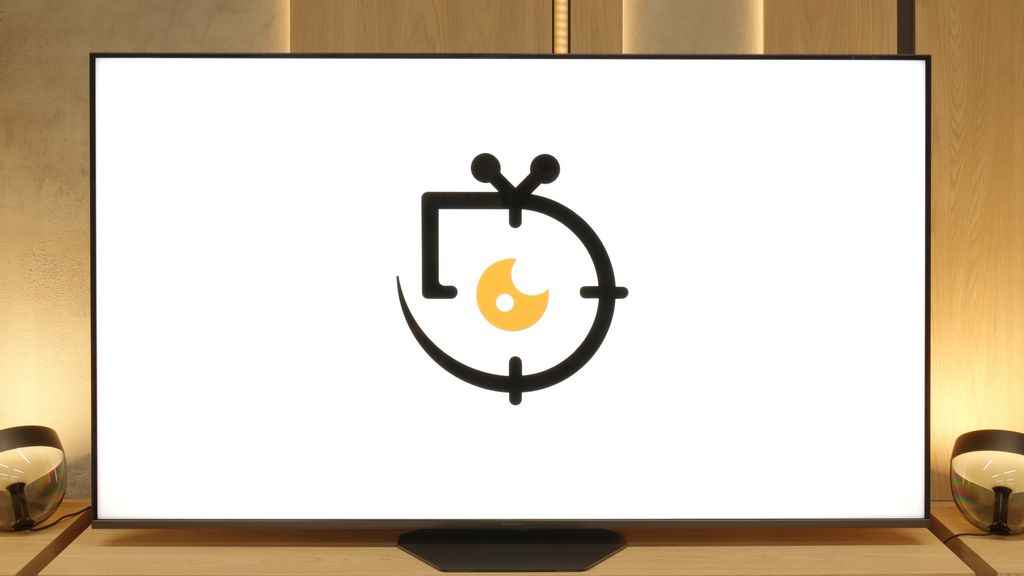
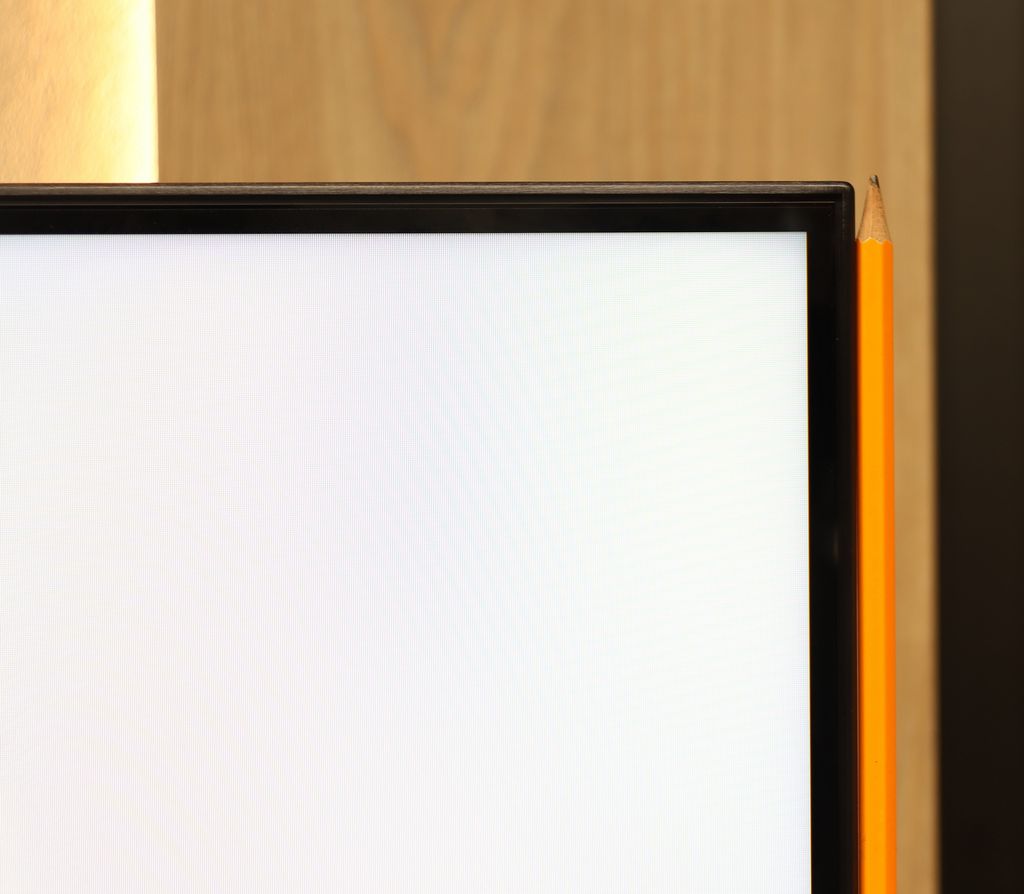
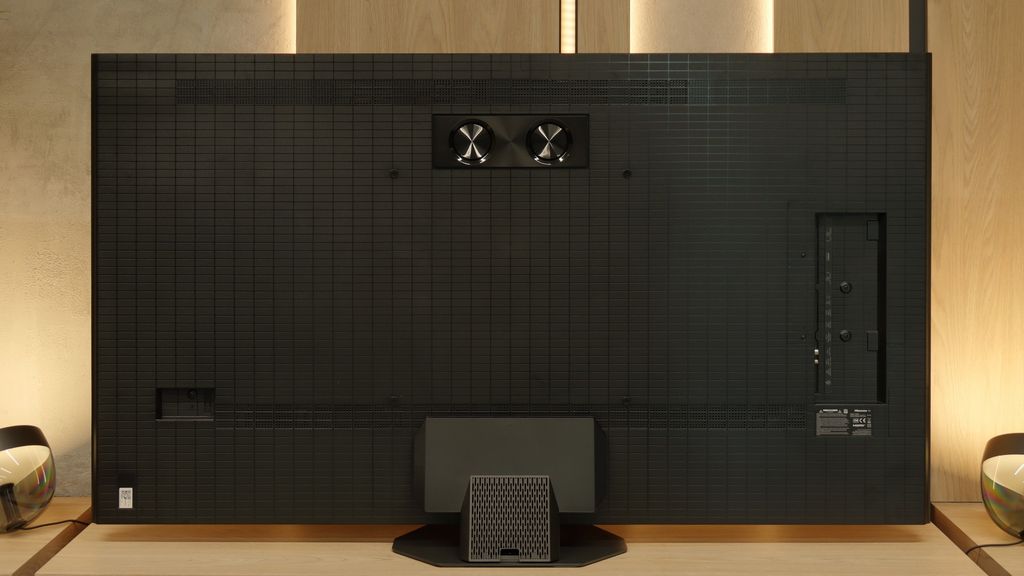
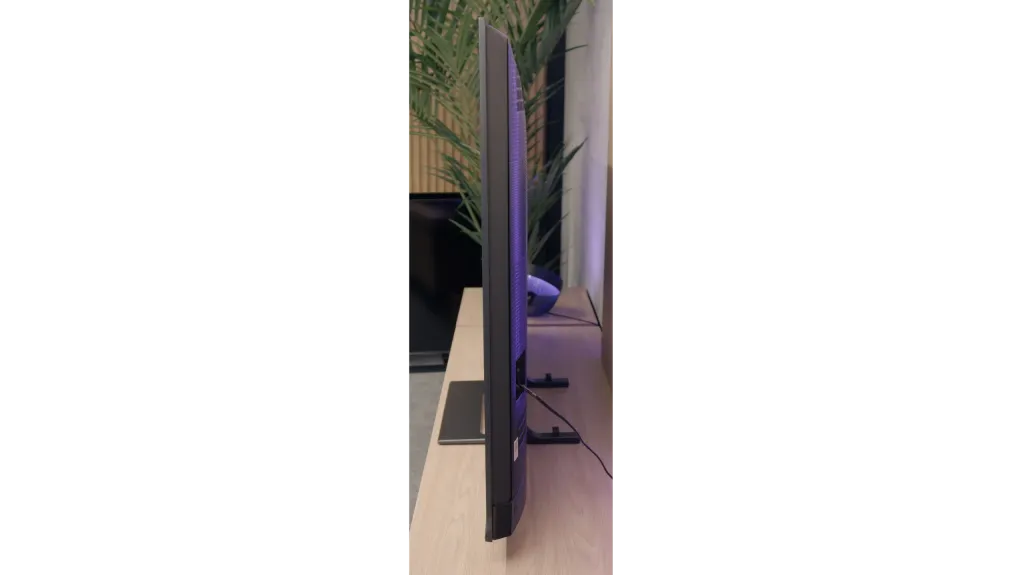




Contrast and black detail
8.6/10
10/10
Local dimming function: Yes, number of zones: 2048 (32 x 64)
Contrast:

Result
1,024,000:1

Result
140,000:1

Result
35,000:1

Result
22,350:1

Result
22,300:1

Result
∞:1

Result
∞:1

Result
∞:1

Result
∞:1

Result
∞:1
Halo effect and black detail visibility:


The unit of Hisense U8Q that we tested, measuring 65 inches, is equipped with a VA panel, which in itself offers high native contrast. However, this is not the greatest strength of this model – the key lies in the Mini LED backlighting. Thanks to the use of thousands of dimming zones and a well-developed light management algorithm, the contrast in the U8Q can be described as excellent, especially for a TV of this technology.
The best results reach a level of around one million to one – a result that commands respect and places the U8Q among the top Mini LED televisions. Indeed, there are certain hiccups and even drops in contrast, but they are not as dramatic as in many other models of this class that we have tested on our portal. It should also be noted that like every Mini LED television, the U8Q is not entirely free from typical imperfections – sometimes the image may be dimmed too much or slight blooming with a halo effect may appear. However, this does not change the overall impression: the contrast in the Hisense U8Q is stunning and constitutes one of the greatest assets of this model.
In terms of black levels and contrast, the Philips OLED770 does not introduce any revolution – but with OLEDs, it would be difficult to expect one. The organic matrix allows for the complete dimming of individual pixels, which in practice gives us almost perfect black and contrast that reaches infinity. Whether we are watching night scenes in films or scenes full of small bright points, the television precisely separates details from the background. There are no halo effects or other artifacts typical of LCD televisions with local dimming. Choosing an OLED – including the 770 model – provides assurance that in this category, the picture will look stunning.
HDR effect quality
7.6/10
6/10
Luminance measurements in HDR:

Result
2195 nit

Result
725 nit

Result
1652 nit

Result
485 nit

Result
1541 nit

Result
546 nit

Result
657 nit

Result
726 nit

Result
704 nit

Result
275 nit
Scene from the movie “Pan” (about 2800 nits)


Scene from the movie “Billy Lynn” (about 1100 nits)


Static HDR10


Dynamic: Dolby Vision
Dynamic: Dolby Vision


HDR luminance chart:
Philips OLED770
HDR luminance
Luminance of RGB colors
Hisense U8Q
HDR luminance
When it comes to HDR, the Hisense U8Q shows its claws. On paper, that is, in synthetic measurement tests, the television can achieve nearly 4000 nits of peak brightness. This is a value that most models can only envy. In practice, this translates to very strong light effects in films – in some scenes, we managed to measure a real brightness of between 1500 and 2000 nits, which is a level typically reserved for the absolute top tier of televisions on the market.
Of course, it's not always perfect. In small, pinpoint elements, brightness can drop – a good example is scene number 4 from the film Sicario 2, where instead of thousands of nits, we get around 500. But it’s worth noting that the effect does not disappear completely – the light is still visible, and the image does not seem artificially dimmed. This is a typical issue with Mini LEDs, so it's difficult to consider this a major downside.
On the other hand, the colour reproduction is a huge plus. Thanks to additional coatings that enhance colour saturation, the U8Q nearly covers the entire DCI-P3 colour space (98%), and for the wider BT.2020 range, it achieved over 80%. This is an excellent result that makes HDR films look rich, vivid, and simply very cinematic.
The Philips OLED770 does not attempt to compete with the brightest OLEDs on the market, and it would be difficult to expect that, as it is the entry-level model in Philips' range for 2025. In our measurements, it reached a maximum of around 700 nits, which allows enjoyment of HDR effects in scenes where light appears sporadically – for example, in the flash of headlights or a starry sky. In such moments, the image can truly be stunning. However, it is different when there are more bright elements on the screen. The television, like many cheaper OLEDs, limits luminance in those situations, causing the entire image to noticeably dim. This was best observed in a scene from the film The Meg, where the sun comes out behind an oil rig – the brightness then dropped to around 250 nits, which is almost three times less. The HDR effect remains pleasant to the eye, but it is worth being aware that this model performs best in scenes with less intense light. Fortunately, the OLED770 has a trump card – the coverage of the DCI-P3 colour gamut is as high as 99%, so colours in films and games are vivid and very close to what the creator intended to convey.
Factory color reproduction
7/10
6.2/10


Factory Mode
After calibration


Factory Mode
After calibration
We must admit that when the U8Q arrived at our editorial office, we were slightly surprised… and positively so. Usually, in televisions, the white balance immediately requires adjustment – it can be too warm or too cold, which immediately leads to strange colour mistakes. Meanwhile, here the situation looks really good straight out of the box. Of course, we are talking about our unit, so there is no guarantee that every model will be equally well calibrated, but in our case, the first impressions were very positive. The only more apparent issue concerned the way the television manages brightness. Looking at the EOTF graph, it is clear that the U8Q tends to brighten small elements on the screen. This, in turn, caused what we mentioned earlier – slight overexposure and the impression that the entire scene can be a bit too bright. However, this is not a flaw that undermines the picture, rather an effect characteristic of this model.
The first measurements already show that the factory settings of the Philips OLED770 have quite a lot to improve even in Filmmaker mode. The white balance chart clearly shows a lack of blue, resulting in a slightly yellowish tint to the image. In practice, the white is not snowy but leans towards warmer tones – which some may even appreciate, but from the perspective of accuracy, this is a deviation from the norm. The gamma, on the other hand, tends to the darker side – the average value is around 2.6 instead of the reference 2.4. In the midtones, the image appears subdued and more saturated, which may seem too "filmic," but detracts somewhat from naturalness. However, the most issues are evident in colour reproduction. The average error is relatively high, and some colours – particularly shades of grey – deviate significantly from what one should see. In everyday viewing, this means that sometimes colours may look less natural than we would like.
Color reproduction after calibration
8/10
9/10




Of course, we wouldn’t be ourselves if we didn’t make adjustments to the white balance. After calibration, we managed to equalise the SDR signal to practically perfection – older films, YouTube content, and classic television looked almost ideal on the U8Q. This is truly an exceptional level that shows this model can do a lot if given a bit of help. Unfortunately, the situation is different with HDR content. The colours themselves don’t pose many problems, but the U8Q’s biggest issue remains the EOTF brightness characteristics. In practice, the television tends to “over-expose” beyond how the image should look in its original form. It’s that slight "bleeding" that we noticed earlier in comparisons with the best screens on the market. It’s a bit of a shame that this characteristic can’t be fully tamed – if we could maintain equally good control over brightness in HDR as in SDR, we would be dealing with an absolutely reference-quality image.
The Philips OLED770 from the outset signalled that it harboured significant potential, but in its factory settings, it was difficult to see this fully. The picture was often too warm, and some colours appeared to have lost their naturalness along the way. Calibration, however, revealed that it is a very responsive television – it reacted to every adjustment and almost immediately unveiled another layer of its capabilities. The white balance could be set in both SDR and HDR to eliminate the yellowish tint and introduce a neutral, clear white. The gamma stabilised closer to perfection, allowing midtones to regain their naturalness, and shadows stopped being artificially darkened, perhaps even with a slight brightening effect. The result was obvious... Films were watched with greater ease; the picture had cinematic depth, but without the feeling that something was exaggeratedly darkened. However, the most interesting aspect was the work on colours. Factory errors were not dramatic but slightly noticeable – skin tones were sometimes too warm, and grey didn’t always have the shade we expected. After calibration, the error values dropped to around 2, and in many cases even below 1. This is certainly a level lower than the threshold of human perception. In other words, after correction, the colours finally "clicked" into place. Looking at the screen, we had the impression that the television had begun to speak with its full voice. Like an instrument that has finally been well tuned.
Smoothness of tonal transitions
8.9/10
7.6/10












When it comes to the fluidity of tonal transitions, the Hisense U8Q made a really great impression on us. Even in the darkest scenes, where unsightly bands and ugly transitions usually appear on other televisions, here the image remains smooth and cohesive. Nothing layers, there is no "stair-step" effect – everything looks as it should. Similarly, in brighter shots – it is also very good. Sure, if we looked through a magnifying glass, we would probably find some minor flaw, but during normal viewing, it's hard to complain about anything. Overall, it performs very, very well!
In this category, there is a clear improvement compared to last year's Philips models. The OLED770 handles colour gradation significantly better, and strongly visible transitions or artificial bands appear less frequently than before. Interestingly, we achieved the best results in dark scenes – where most televisions, especially those with WOLED panels, tend to struggle the most. A good example is the shot of an actor floating in red water – the transition from intense red to black looks nearly perfect here, without the typical "stair-stepping." The situation is somewhat worse in bright parts of the image. With extremely bright gradients, especially close to white, the television struggles to maintain smoothness. This can be observed in a scene from the film Kingsman, where subtle sunrise bands appear in the background of a bright sky with the sun instead of a smooth blur. Fortunately, these are relatively rare situations, and in everyday viewing, the OLED770 performs very solidly and does not disrupt immersion as was the case with last year's models.
Image scaling and smoothness of tonal transitions
8/10
7/10
Smooth transition function
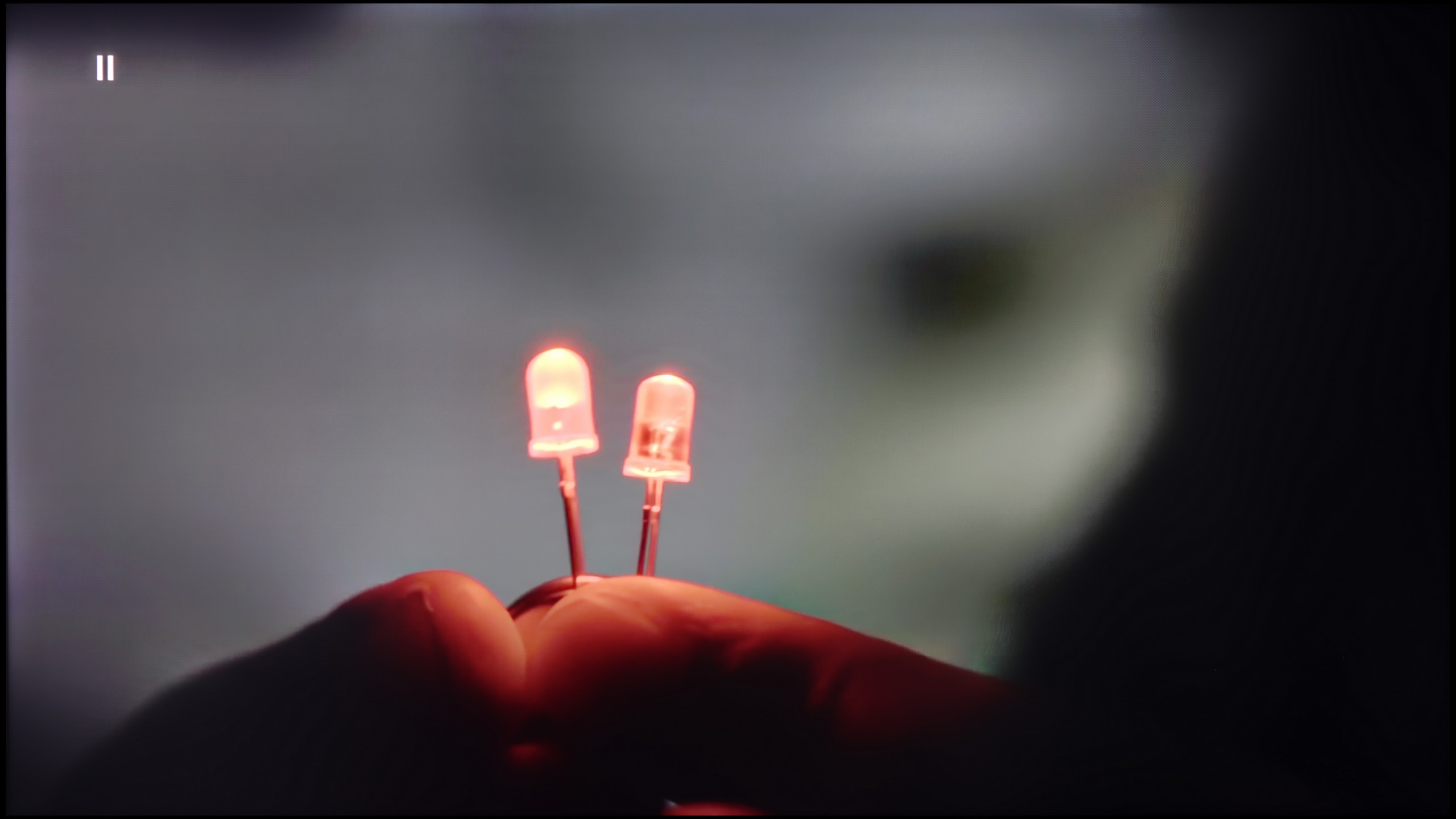

Image without overscan on the SD signal


Hisense U8Q handles lower quality materials quite well. The television can smooth out tonal transitions thanks to the "Smooth and Gradient Picture" feature – it works best when set to Medium. At this setting, it nicely dims unwanted bands and unevenness in the picture, but importantly, it does not remove the film grain or fine details.
The upscaling itself is also at a good level. Images from lower resolutions appear smooth and soft, sometimes even overly so – we get a plastic effect that may not appeal to everyone. Fortunately, this can be easily corrected with the sharpness slider, allowing the picture to be adjusted to personal preferences.
The issue of the aforementioned colour banding can largely be mitigated thanks to the 'distortion reduction' feature, which is an algorithm for smoothing tonal transitions in Philips. It performs best at a low setting – effectively eliminating unwanted colour bands while not introducing strange artefacts or losing image detail. This is one of those features that is truly worth leaving switched on.
The situation is somewhat worse regarding upscaling. The image from a lower resolution can be too soft, while in some areas, characteristic 'jaggies' appear. The impression is that the algorithm is trying to reconcile two conflicting directions – smoothing and sharpening – and ultimately fails to find a happy medium. As a consolation, it can be added that the television has no issues with overscan, meaning it does not cut off the edges of the image, which sometimes occurs in other competing models.
Blur and motion smoothness
7.8/10
8.4/10
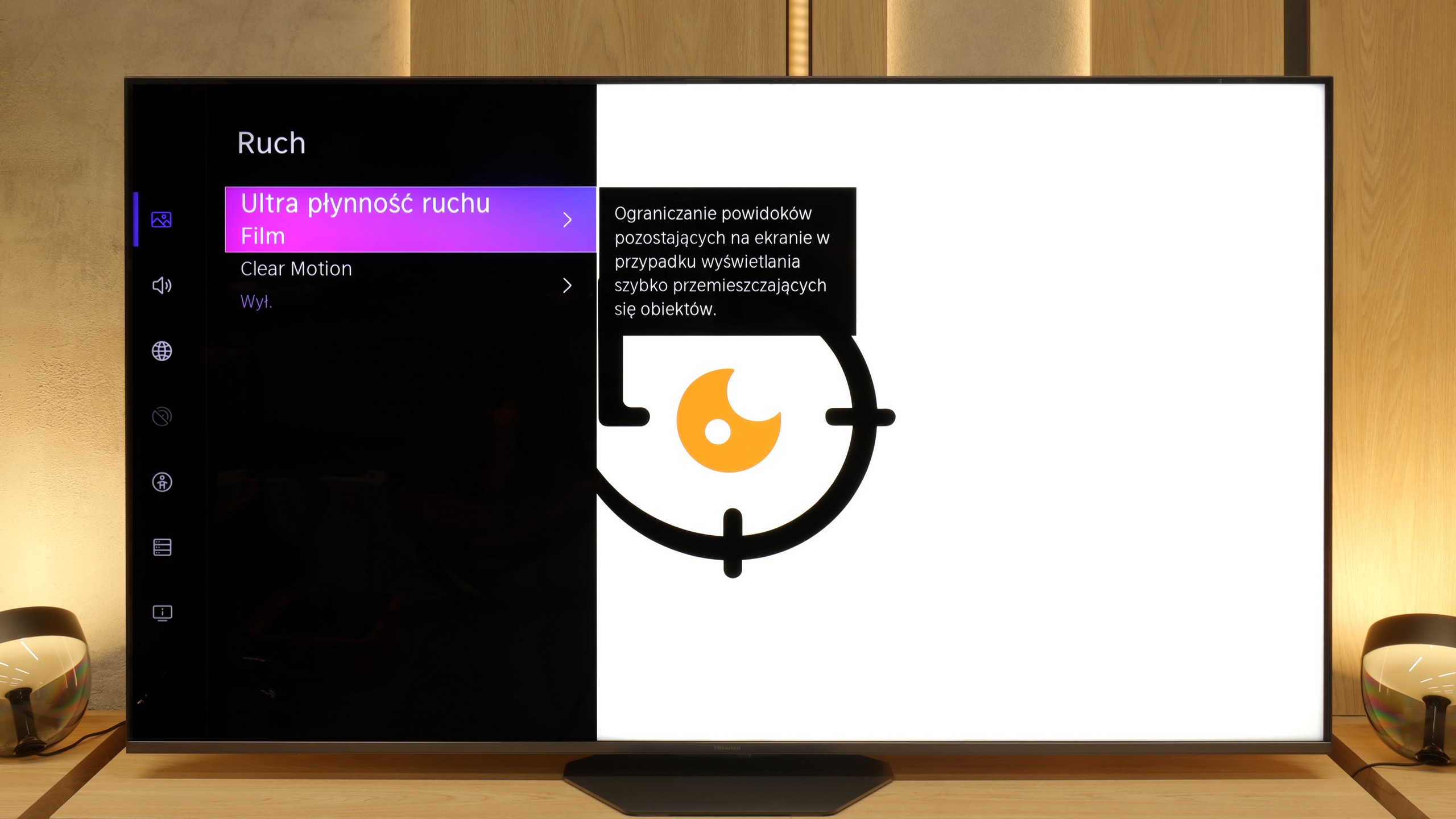

Blur (native resolution, maximum refresh rate):
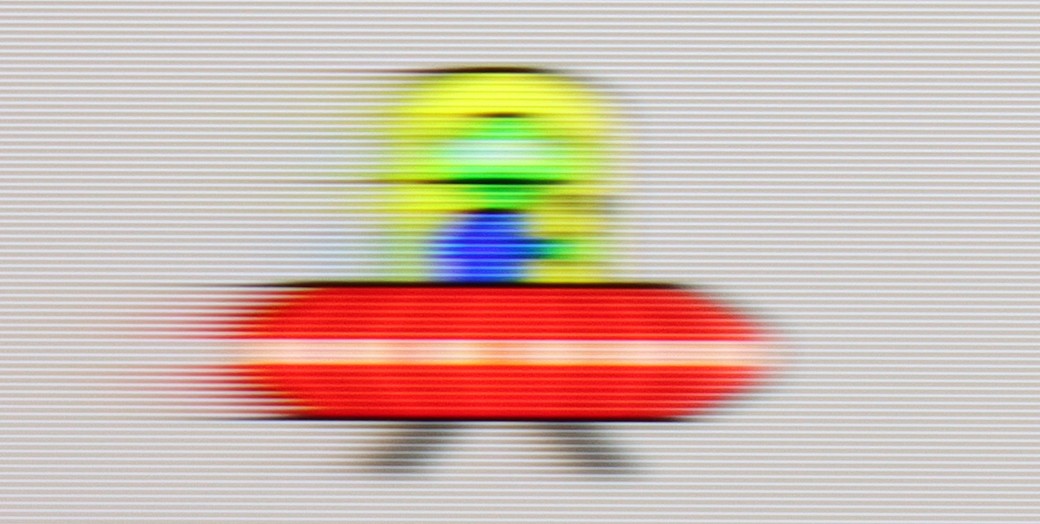
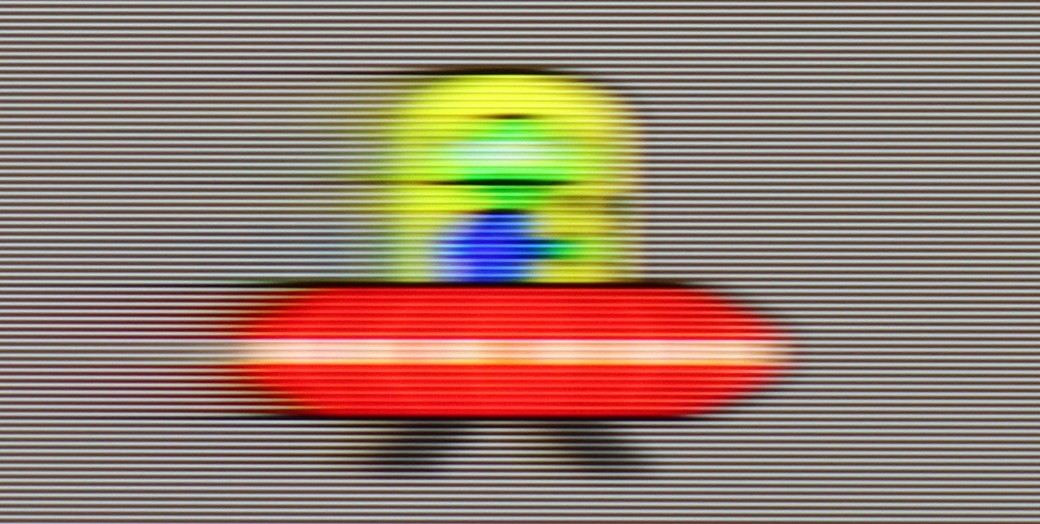
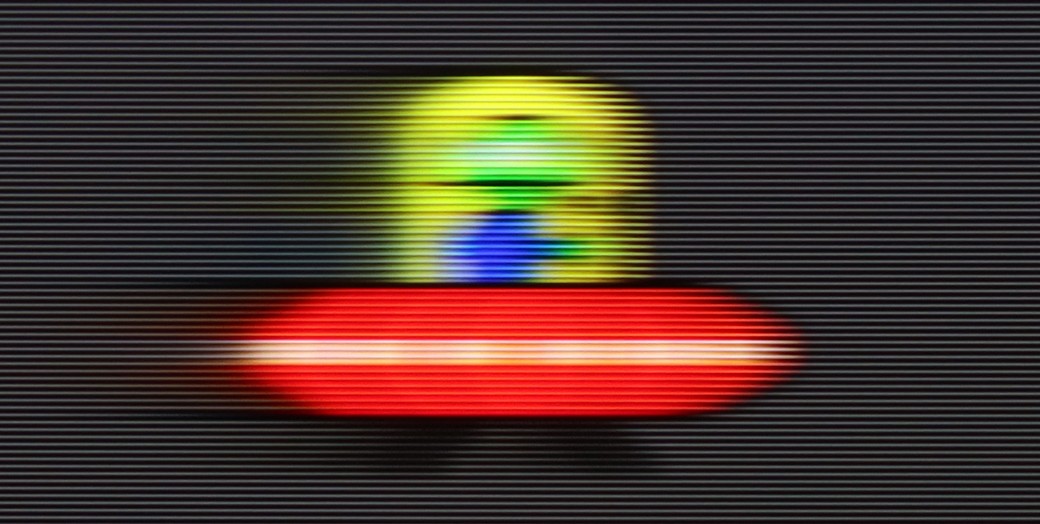



Blur (BFI function enabled):



Smużenie (1080p@288Hz):

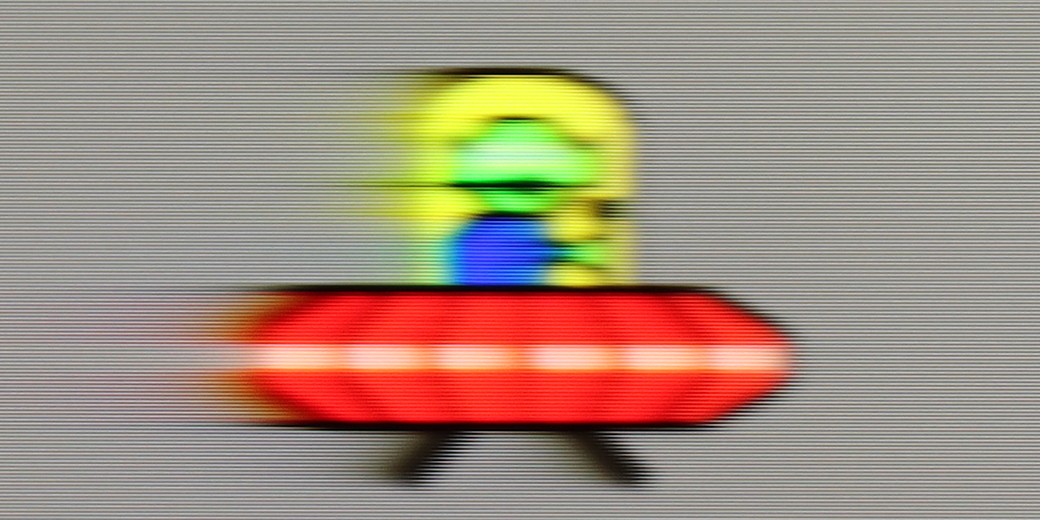

Smużenie (4K@144Hz):



Hisense U8Q features a panel that can refresh the image up to 165 Hz in 4K resolution. In practice, this will primarily be utilised by PC gamers, but as the saying goes – it’s better to have it than not 😊. For films and series, we have a built-in smoothness enhancer called Ultra Motion Smoothness. In the settings, it can be easily adjusted to suit personal preferences – whether we want a more “cinematic” frame rate or a smooth, theatrical spectacle.
The issue of the matrix in the Philips OLED770 is not entirely straightforward. The manufacturer claims a 120 Hz panel, but our measurements showed that the screen can accept a 4K signal even at 144 Hz. That sounds like great news – after all, who wouldn't want an additional mode for PC gamers at this price? However, the reality turned out to be more complex. With 120 Hz content, the television behaves like most OLEDs – the image is absolutely clear, with no trace of ghosting or blurring, making it perfect for both dynamic games and sports broadcasts. The problem only arises at 144 Hz. Unlike models with official support for this frequency, here you can observe the phenomenon known as frame skipping. This means that the television cannot display all the frames – some are skipped, causing motion to lose smoothness, and double contours appear on the screen. The effect resembles the operation of the BFI function, which Philips does not offer in this model anyway.
Console compatibility and gaming features
8.5/10
10/10
- ALLM
- VRR
- VRR range48 - 288Hz40 - 120Hz
- Dolby Vision Game Mode
- Correct implementation of HGIG
- 1080p@120Hz
- 1440p@120Hz
- 4K@120Hz
- Game bar
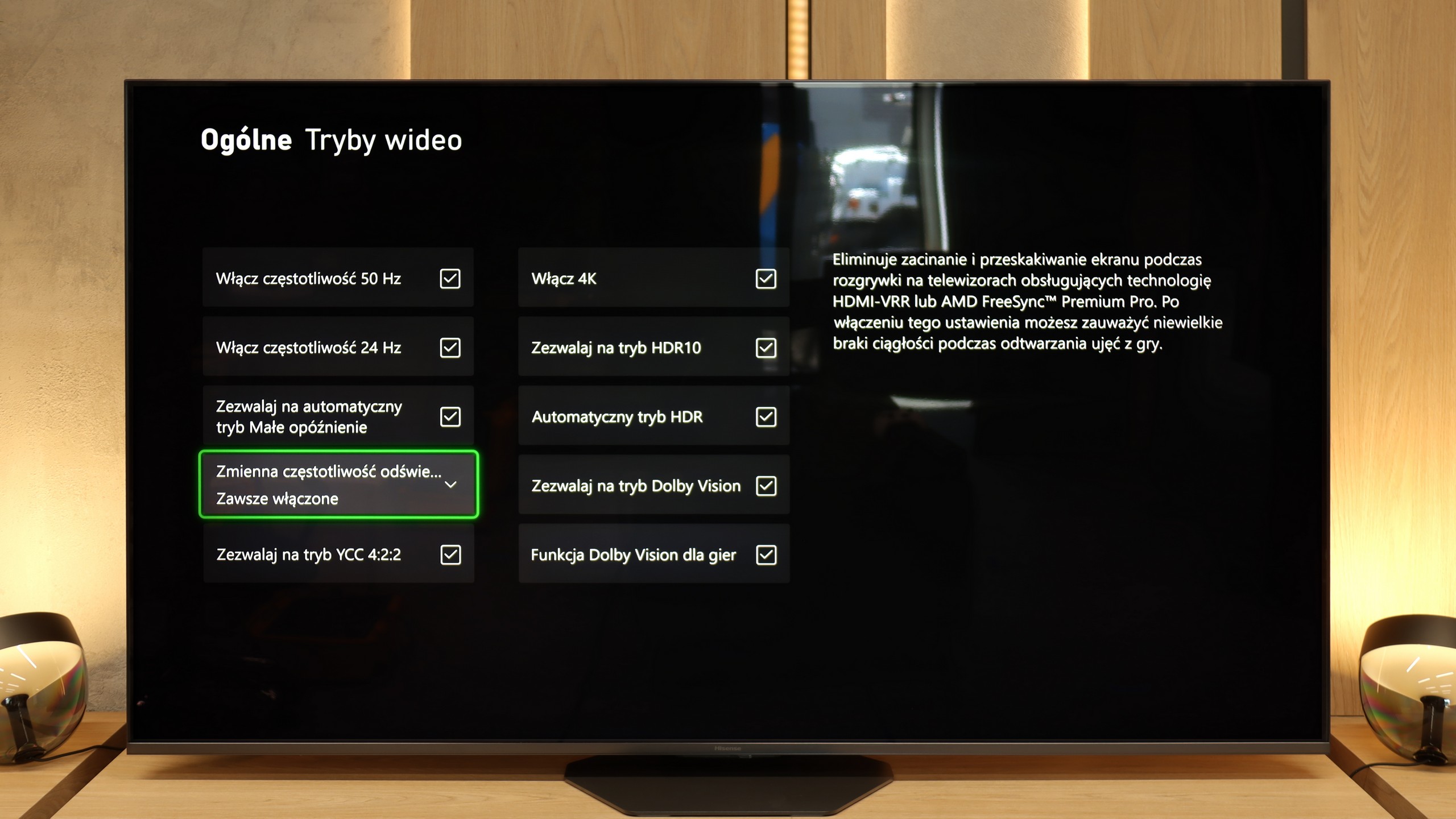

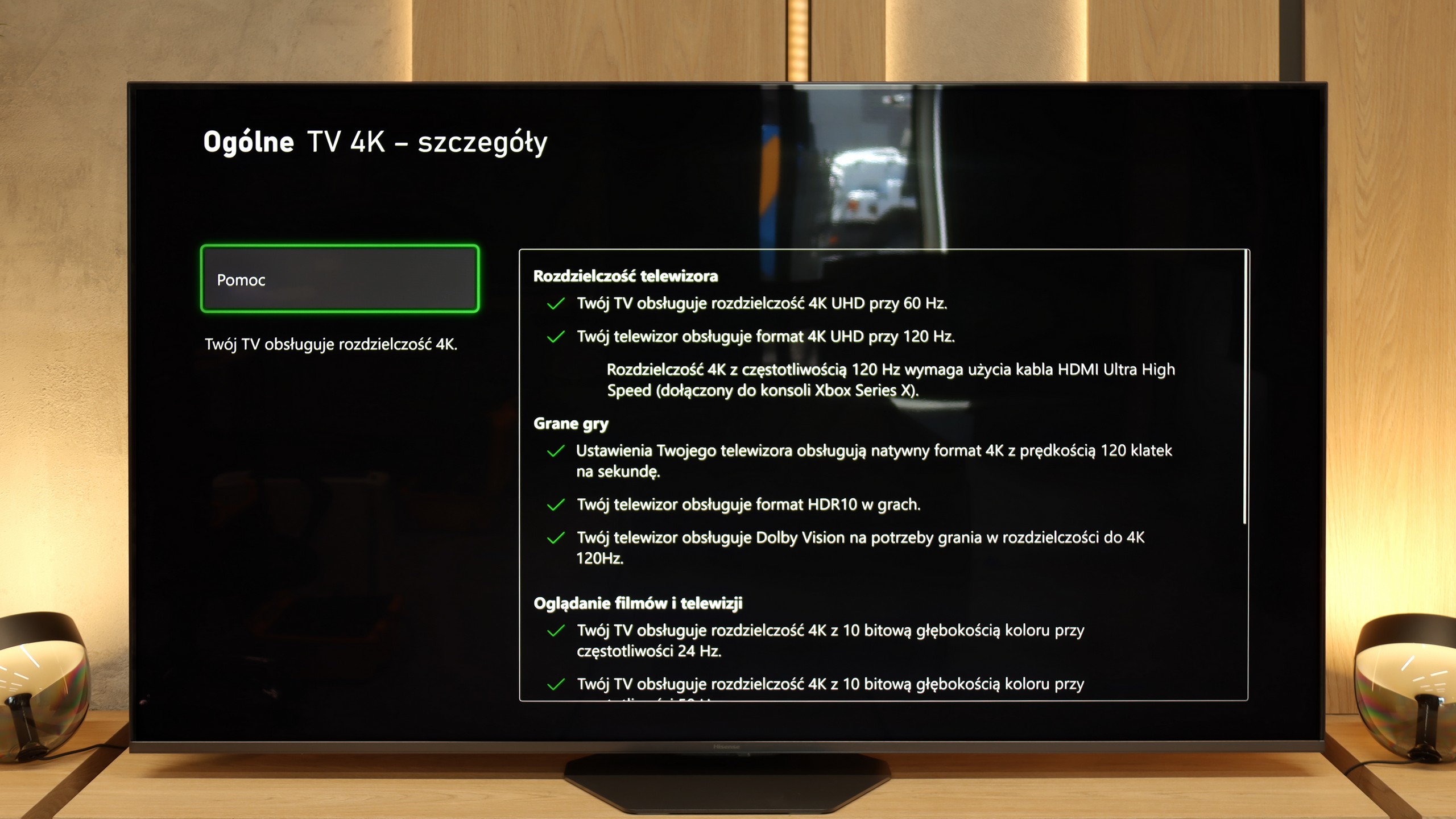

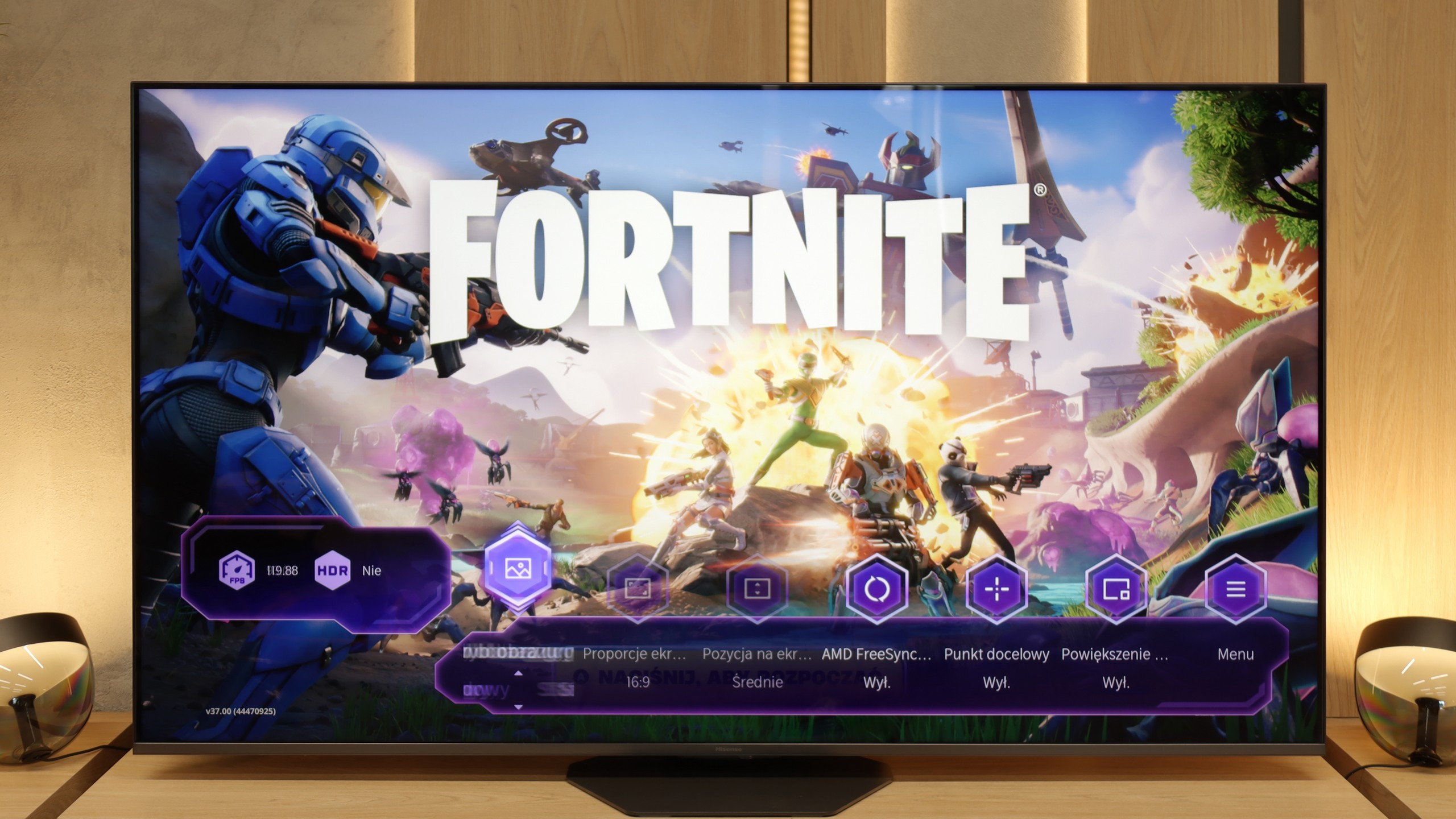

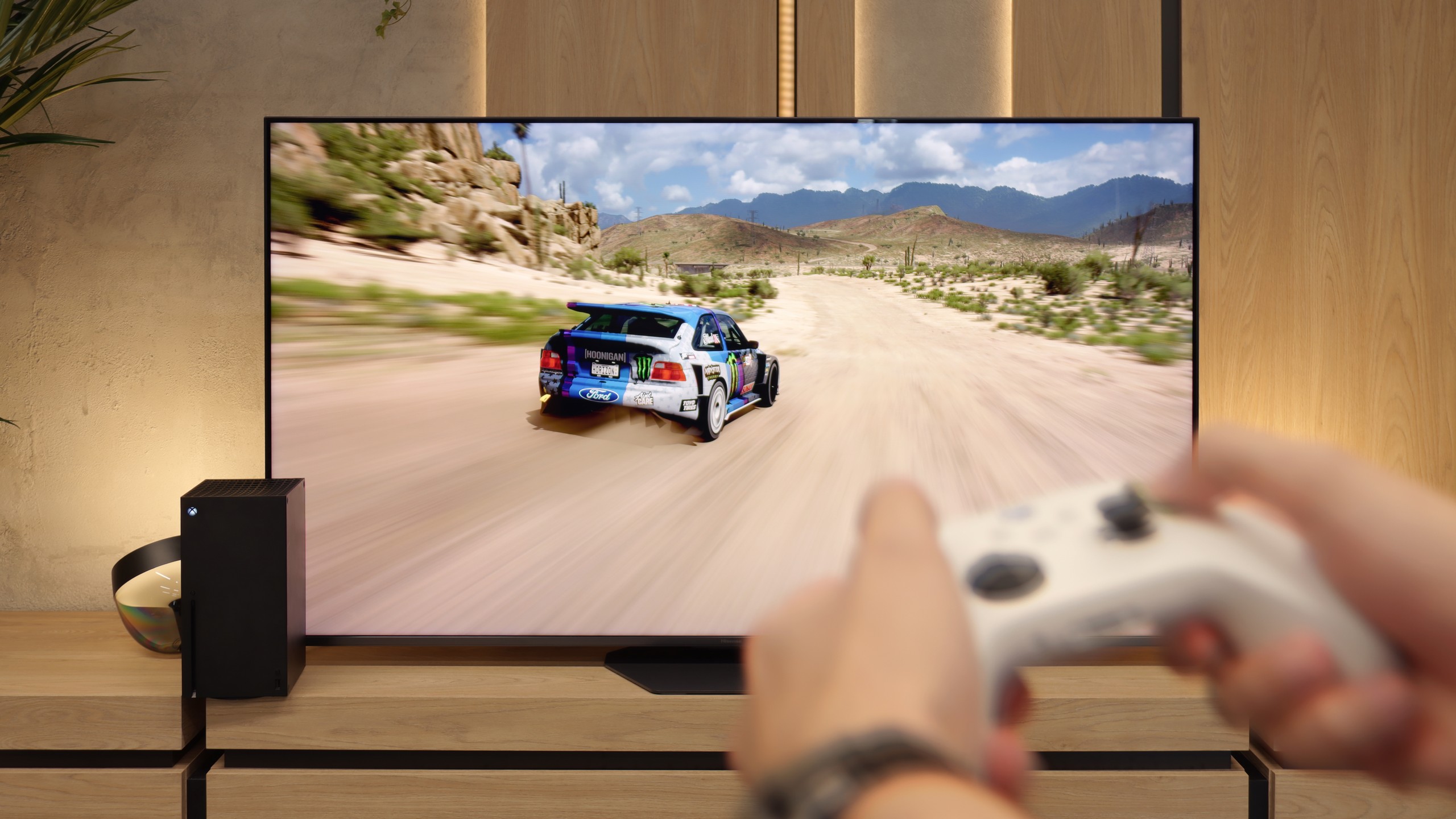

In terms of features, the Hisense U8Q has practically everything one could expect from a modern gaming television. Thanks to the new processor, the manufacturer managed to implement as many as three HDMI 2.1 ports, so there is no problem connecting several consoles or a computer. On top of that, it includes all the key technologies – Game Bar with parameter preview, variable refresh rate (VRR), automatic low latency mode (ALLM)… in a word, a complete set.
But as is often the case with Hisense, it fell a bit short of perfection. The biggest drawback remains the lack of support for the HGiG format, which allows the brightness of the television to be adjusted to the console and maximises HDR in games. It’s a shame, because if this element were included, we would have a device practically made for gamers. As it stands, the U8Q remains “only” a very good choice 😉
If someone is looking for a television for gaming, the Philips OLED770 is a contender that is hard to ignore. The mere fact that we have an OLED here provides an excellent starting point – perfect black and infinite contrast make evening sessions in atmospheric games look as if they were lifted straight from the cinema. On top of that, there is the Ambilight system, which consists of LEDs on the back of the television that extend the image onto the wall behind the screen. The effect is such that even playing FIFA can look like a small spectacle, and in horror games the atmosphere becomes truly thick. From a technical standpoint, it's also quite decent. The Philips OLED770 supports variable refresh rate (VRR) up to 120 Hz, has an automatic mode for gamers (ALLM), and if someone is using an Xbox Series X, they can also count on Dolby Vision support in games. One must only know that in this mode the input lag is slightly higher than standard, though still at an acceptable level. As a bonus, we get the “Game Bar” panel, which is a special tool bar for gamers. It isn’t the most conveniently designed solution, but it allows you to check key parameters without leaving the game. Overall, this results in a television that, on one hand, has all the essential gaming features, and on the other, can add something unique – Ambilight. And it is this mix of technology and visual effect that makes the OLED770 one of the better screens for gaming at home.
Input lag
9.8/10
9.8/10
SDR
HDR
Dolby Vision
The Hisense U8Q really handles signal delay well. In 120 Hz mode, the input lag is around 10 ms, while with 60 Hz content it hovers around 18 ms. These are values that place it among the fast televisions, and in practice, it is difficult to have any significant complaints about them. The response is instantaneous; controlling a character or a car on the screen happens without perceptible delays. Whether someone is playing fast-paced shooters or calmer narrative titles, the U8Q performs excellently.
As we mentioned earlier, the only anomaly that was detected during testing is the Dolby Vision Gaming mode. In this setting, the delay can reach up to 30 ms. This is not particularly impressive, and more demanding gamers may wrinkle their noses, but in practice – during casual sessions – the difference will not be strongly noticeable. Standard HDR10 and SDR modes perform much better. For a 120 Hz signal, input lag drops here to a minimal 5 ms, which is an outstanding result and places the OLED770 among the top televisions suitable for fast-paced gaming. In other words, if someone is not insistent on using Dolby Vision on Xbox, the gaming experience will be quick, smooth, and free of unnecessary delays!
Compatibility with PC
8.4/10
7.6/10
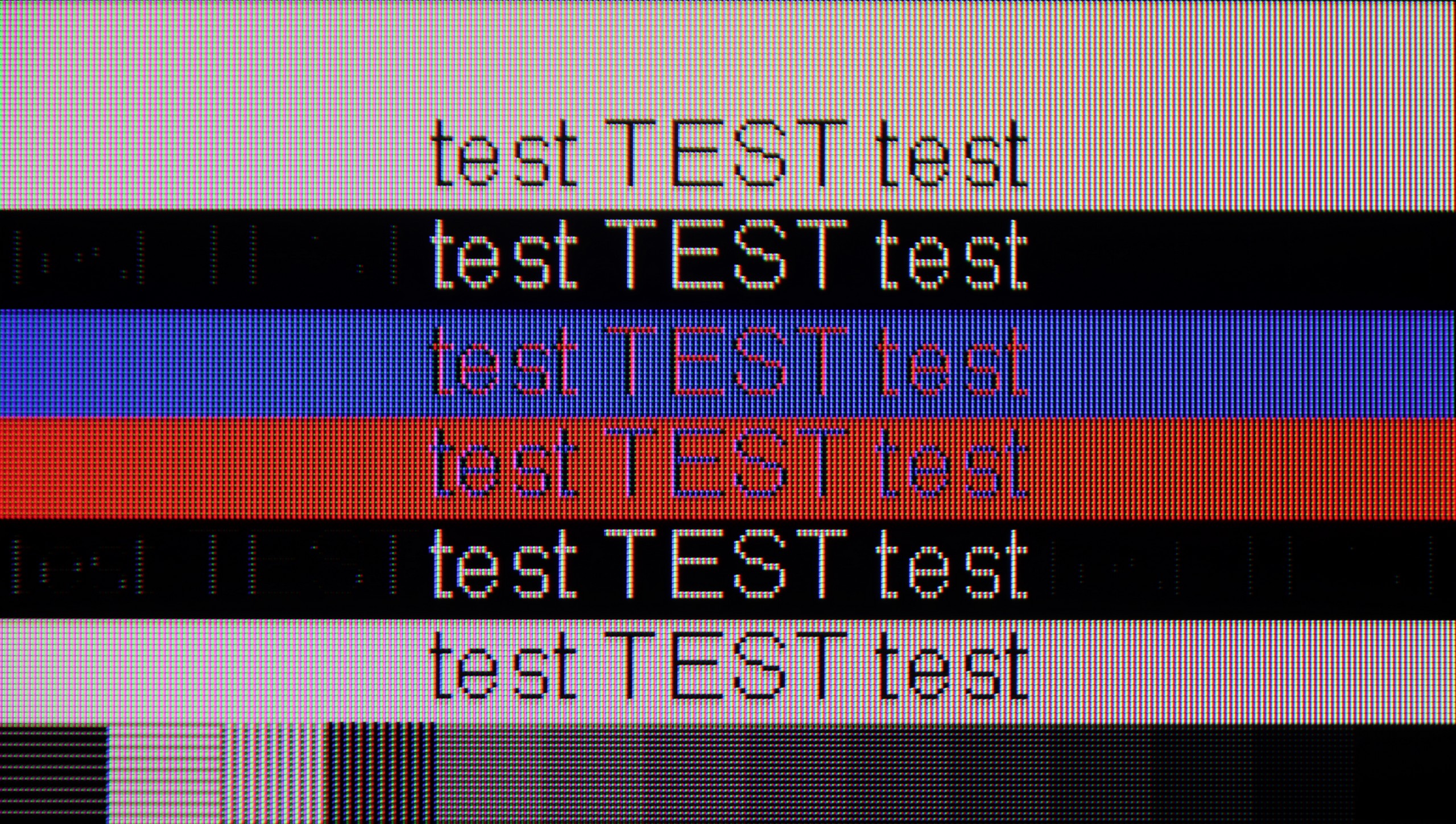

As we mentioned regarding the features for gamers – Hisense U8Q also communicates well with computers. The 4K panel with a refresh rate of 165 Hz is impressive on its own, and at Full HD resolution, it can even boost to 288 Hz. This is great news for e-sports fans, where speed of reaction matters most, rather than the highest image quality. Additionally, it supports G-Sync and FreeSync, so gameplay is smooth, without stutters and annoying frame tearing.
A pleasant surprise is the presence of a USB-C port with DisplayPort functionality for laptops or even phones. This is a true novelty in televisions, and it's quite possible that Hisense will be a pioneer here, setting the direction for the competition.
When it comes to working with text, we must mention one small inconvenience. Although the U8Q correctly handles chroma 4:4:4, it has issues displaying very thin, horizontal fonts. This means that some subtitles or interface elements may be hard to read. Probably no one buys this model with office work in mind, but if someone were to have such a plan – it’s worth keeping this in mind.
Philips has learned from previous models and has finally improved the implementation of chroma 4:4:4. This is important news for those planning to connect a television to a computer, as it means no issues with sharpness and readability of fonts. Text appears clear and transparent, so the OLED770 can aptly be called an excellent screen for office work or browsing the internet. Of course, very demanding users may notice some imperfections resulting from the WRGB pixel arrangement typical of WOLED panels, but in practice, this does not significantly impact comfort. The television also performs well in games run from a PC. The panel allows for real refresh rates up to 120 Hz, and with low input lag, it delivers a very smooth image without noticeable stuttering. The only missing features are support for G-Sync and – as we have mentioned – a proper 144 Hz mode, but despite this, the overall performance is really solid. For those looking for a versatile screen for both computer and console use, the OLED770 is a choice that is hard to overlook.
Viewing angles
3.2/10
7.7/10
In terms of viewing angles, the Hisense U8Q performs averagely – typical for a VA panel. It's a classic compromise: in exchange for much better blacks and contrast than in IPS panels, we must accept that watching from a wider angle does not look as good. Colours begin to lose intensity, and the picture slightly brightens. For a viewer sitting directly in front of the television – it’s a dream. For someone who sits more to the side – it’s a bit less so.
In terms of viewing angles, the Philips OLED770 presents a very high level typical of OLEDs. The image remains clear and vibrant even when viewing the screen from the side – there is virtually no noticeable drop in contrast or colour fading. In this category, it is only surpassed by QD-OLED panels, which can be found either in very expensive premium models or in one exceptional case – the 55-inch Samsung S85F. However, in everyday use, the differences are difficult to detect, and the OLED770 performs nearly perfectly anyway. It is only at truly extreme angles that a slight degradation of colours can be noticed.
TV efficiency during daytime
8.2/10
4.8/10
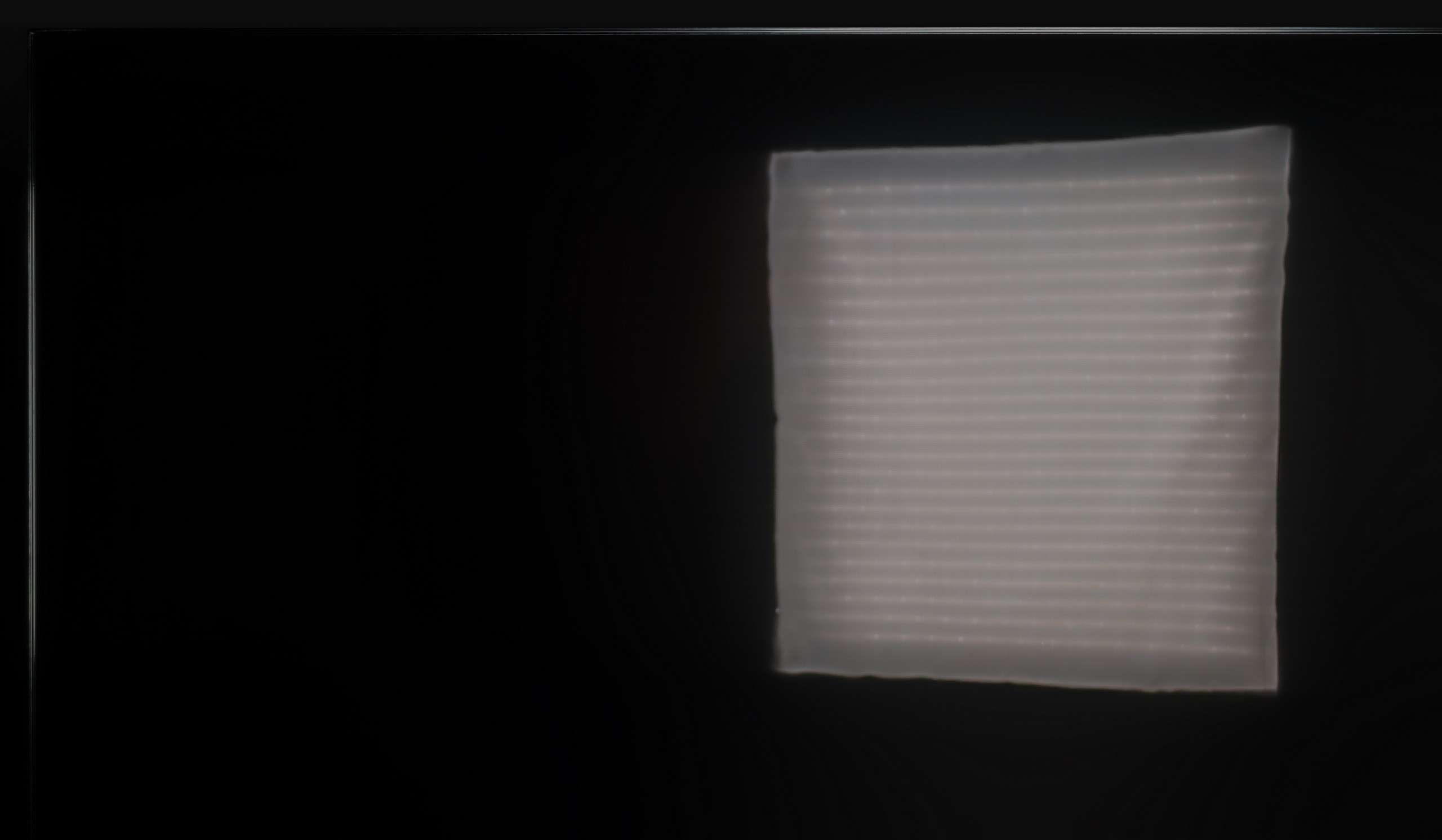



Matrix brightness
Average luminance SDR
Philips OLED770: 249 cd/m2
Hisense U8Q: 914 cd/m2
Hisense has opted for a new anti-reflective coating called Anti-Reflection PRO. It aims to enhance viewing comfort in challenging lighting conditions – and it indeed does the job. Reflections do not disappear entirely, but they are well controlled and do not interfere with daily viewing. However, the highlight is the brightness in SDR – around 1000 nits! This is a result that would make even the top super premium models proud. As a result, the U8Q performs excellently in sunlit rooms and can confidently be considered one of the best televisions for daytime viewing.
OLED770 is not one of the brightest televisions, so it is hard to recommend it for very sunny living rooms. In a bright room, its limitations quickly become apparent – the screen reflects light and acts rather like a slightly dimmed mirror. The suppression of reflections is average, and in direct light, the screen performs poorly. Fortunately, the matrix coating does not distort colours, so even during the day, the hues remain natural, and blacks do not dramatically lose their depth. Nevertheless, it is difficult to say that the OLED770 is a television made for bright spaces – it will definitely perform better in a dimmed living room or a bedroom, where its strong points can fully resonate.
Details about the matrix
Subpixel Structure:

Panel uniformity and thermal imaging:
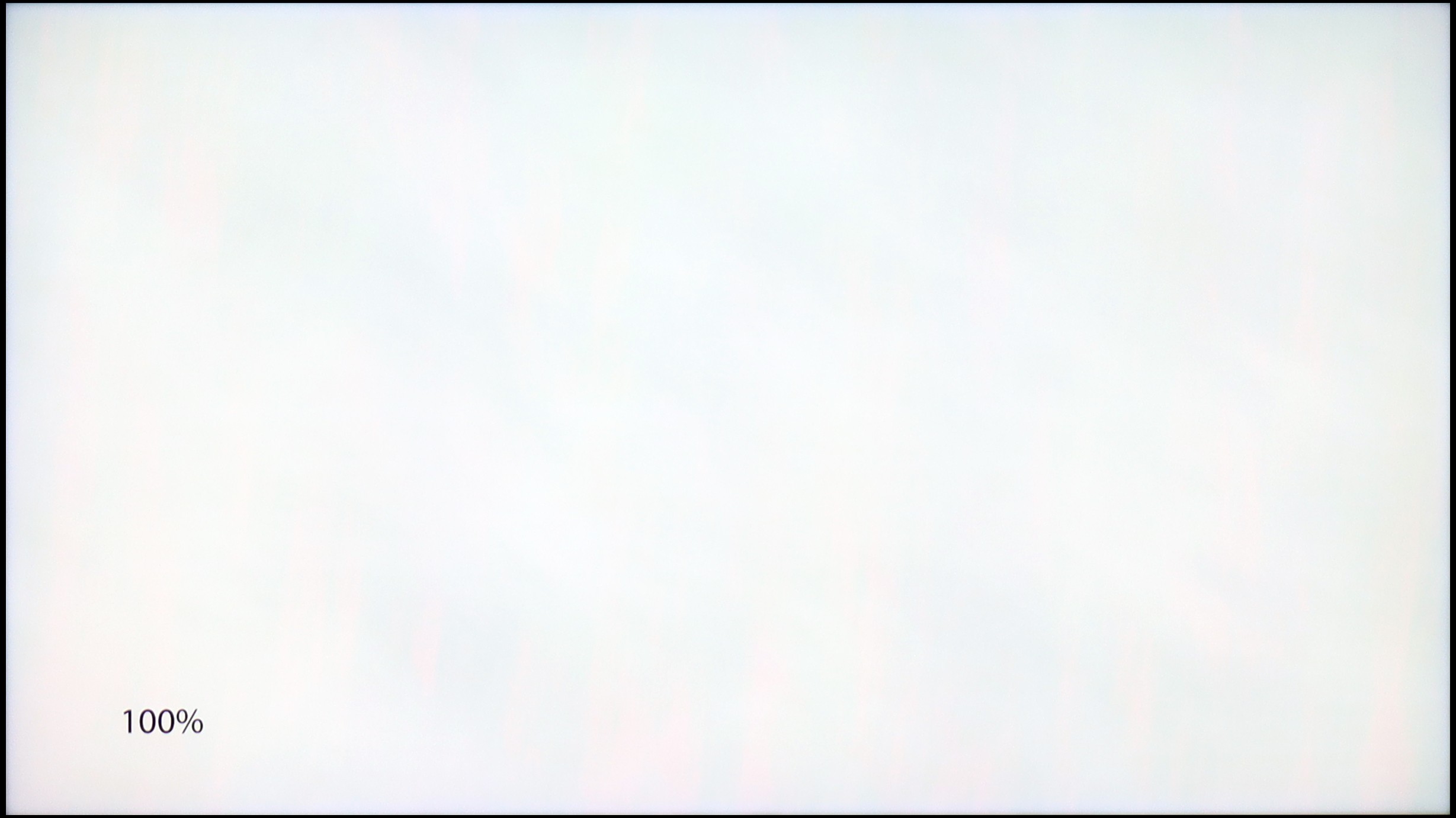

Hisense U8Q
Philips OLED770
TV features
9.4/10
5.5/10
- HDMI inputs0 x HDMI 2.0, 3 x HDMI 2.1 48Gbps0 x HDMI 2.0, 4 x HDMI 2.1 48Gbps
- Other inputsToslink (Optical audio), RCA (Chinch)
- OutputseARC (HDMI), ARC (HDMI), Mini-Jack (Headphones)Toslink (Optical audio), eARC (HDMI), ARC (HDMI), Mini-Jack (Headphones)
- Network InterfacesWi-Fi 2.4GHz, Wi-Fi 5GHz, Ethernet (LAN) 100MbpsWi-Fi 2.4GHz, Wi-Fi 5GHz, Ethernet (LAN) 100Mbps
- TV receptionDVB-T, DVB-T2, DVB-S, DVB-S2, DVB-CDVB-T, DVB-T2, DVB-S, DVB-S2, DVB-C
Classic features:
- Recording to USB (terrestrial TV)
- Recording programming
- Picture in Picture (PiP)
- RF remote control (no need to aim at the screen)
- Backlit remote control
- Teletext
- Audio only mode
- Bluetooth headphones support
- Simultaneous Bluetooth headphones & TV audio
Smart features:
- AirPlay
- Screen mirroring (Windows Miracast)
- Voice search
- Voice search in native language
- Ability to connect a keyboard and mouse
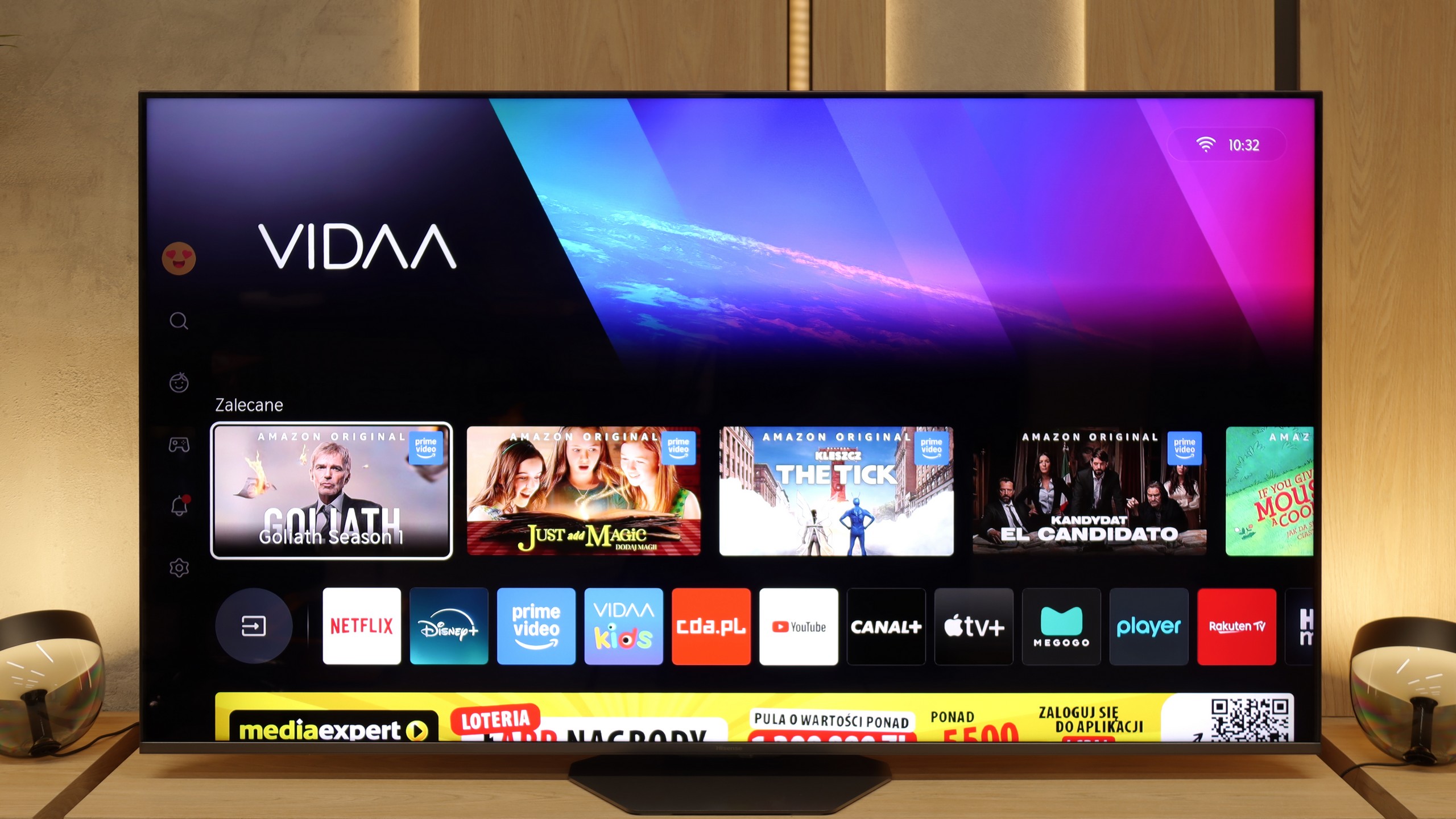
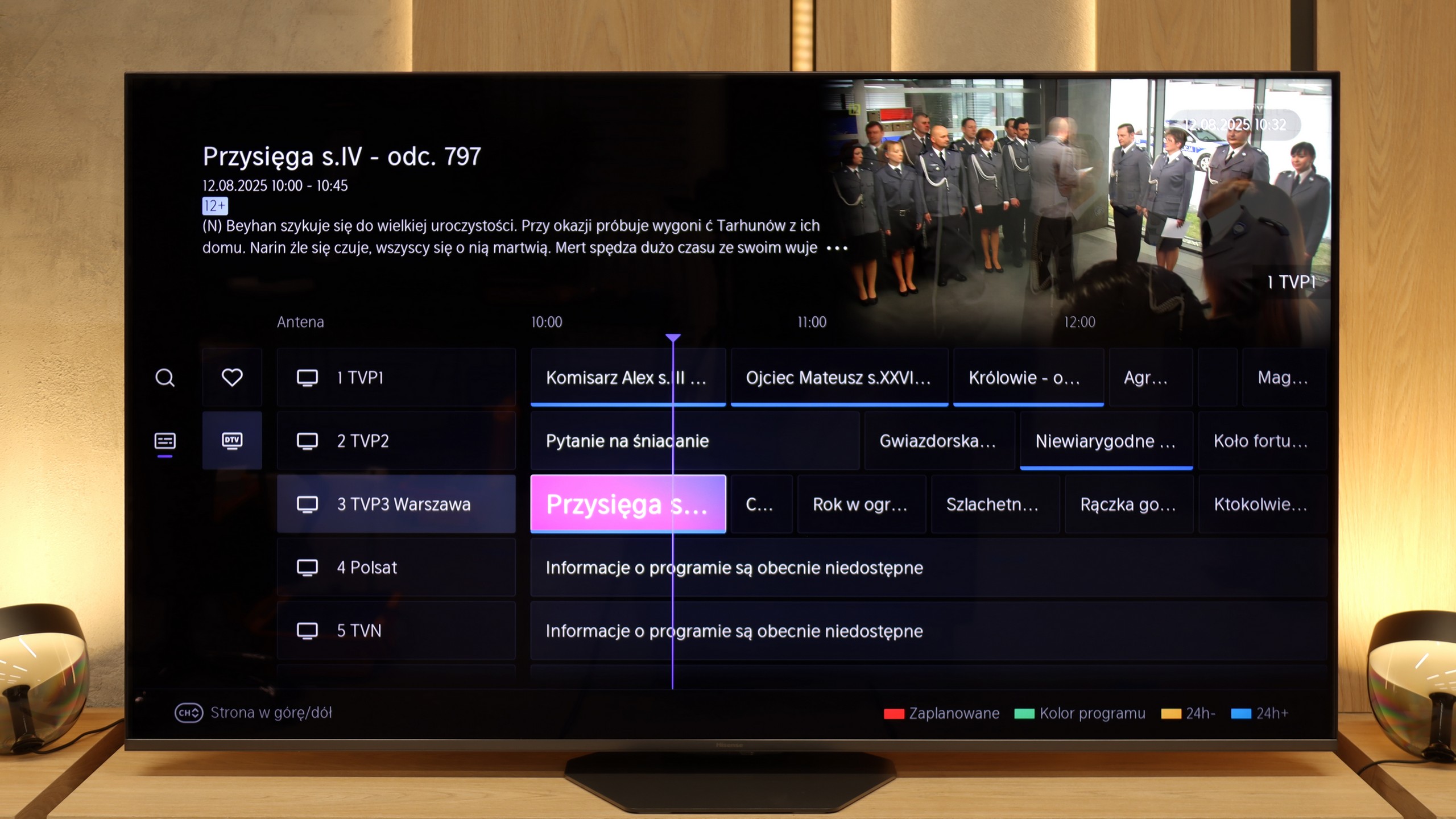
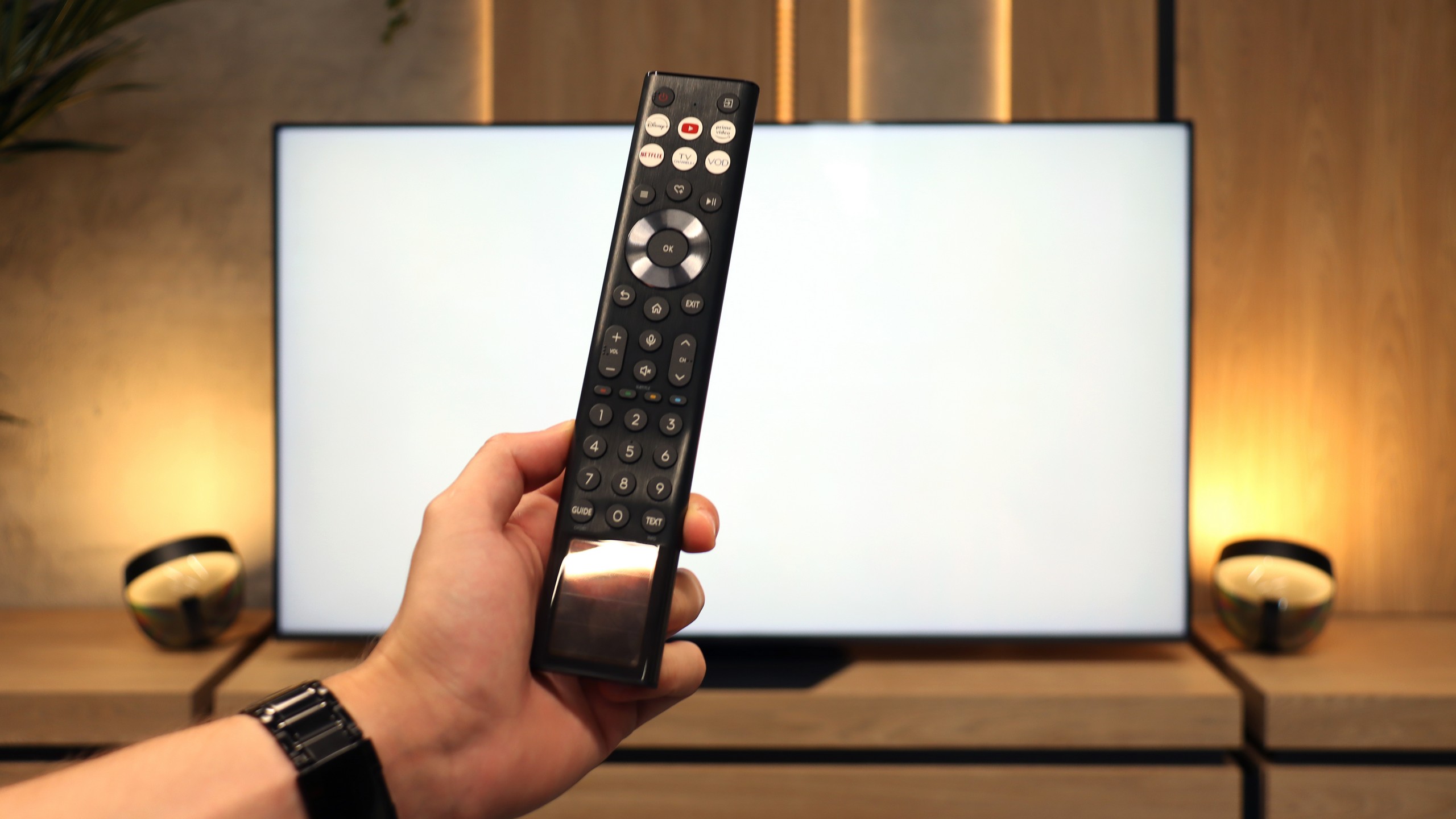
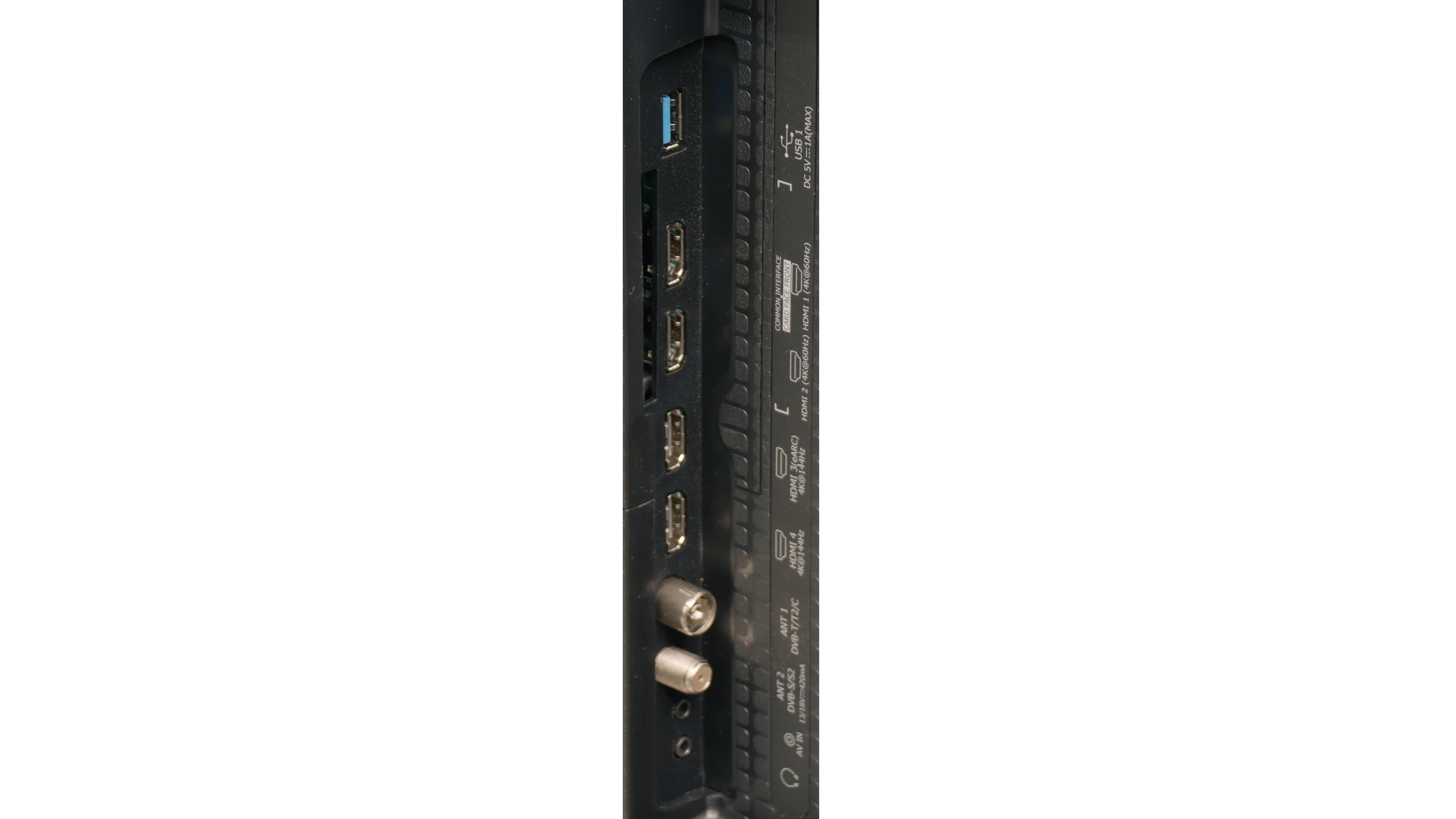




Classic Features
The Hisense U8Q runs on the VIDAA system, which can still be considered relatively new in the European market, but it must be admitted – the manufacturer has a lot to offer here. We find classic features that are still useful to many people: recording to USB, a clear EPG guide, and the ability to connect wired headphones, which will be especially appreciated by seniors. A nice addition is the presence of an audio jack – a connector that is slowly disappearing completely from televisions, yet here it has been retained.
USB-C in the Television!
A new feature in the U8Q is the USB-C port with DisplayPort support. This is an unconventional but very practical solution – thanks to it, you can connect a laptop or phone with one cable, even if these devices do not have an HDMI output.
Smart Features: VIDAA
When it comes to smart features, VIDAA works efficiently. The interface is fast, applications open without significant delays, and network functions – such as screen mirroring or AirPlay – work very well. Of course, there are minor shortcomings, but these are more details than real problems. The Achilles' heel remains the somewhat limited application library. However, it is worth remembering that the list of available programs can change from day to day – some disappear, while others appear, so the situation may improve.
User Functions
Let’s start with the basics, namely the classic functions of a television. The Philips OLED770 doesn’t rock the boat here; it has a standard EPG interface, the ability to connect devices via Bluetooth, and a few simple configuration options, including teletext. A curiosity is the presence of a jack connection, which has become quite rare these days. However, it will be appreciated by owners of older amplifiers or wired headphones. The remote control gives a good impression—it's ergonomic and has backlighting for the numeric keypad—but here too, there is a sense of a step back. It operates on infrared, so you have to aim at the television, and we would expect full wireless support by 2025. The exception is voice commands that use Bluetooth, but even here there is no cause for euphoria.
SmartTV Features – TitanOS
Speaking of voice, let’s move on to the Smart TV system, which largely defines the daily comfort of using a television today. Here, the OLED770 clearly falls behind the competition. TitanOS operates quickly enough that it’s hard to call it a disaster, but everyday use can be frustrating due to minor errors and shortcomings. Theoretically, we get support for AirPlay, but on the other hand, screen mirroring didn’t work at all in practice. Voice search? Yes, but only through Amazon Alexa and without support for the Polish language. In other words, the features exist, but when we try to use them, their utility turns out to be severely limited, even useless. And it is the Smart TV aspect that becomes the biggest hindrance for the OLED770. The picture can be breathtaking, gaming performs excellently, and Ambilight creates a unique atmosphere—yet when we move to everyday use of applications and services, we feel a sense of dissatisfaction.
Ambilight – Philips OLED770
While in terms of smart functionality, the Philips OLED770 is rather average, it has something in store that the competition genuinely envies. We are of course talking about the three-sided Ambilight system, which has been a hallmark of televisions from this brand for years. The LED lights positioned at the back of the casing dynamically illuminate the wall in colours matching what is currently happening on the screen. The effect is simple but very suggestive—the image seems to extend beyond the confines of the television, giving us the impression that the screen has suddenly grown by extra inches. During a film viewing, it can create an atmosphere, in games it enhances immersion, and during everyday television watching, it simply pleases the eye. It is this addition that makes, despite the limitations of TitanOS, the OLED770 have something that can attract attention and give it character.
Playing files from USB
8.3/10
8.5/10
Supported photo formats:
Maximum photo resolution:
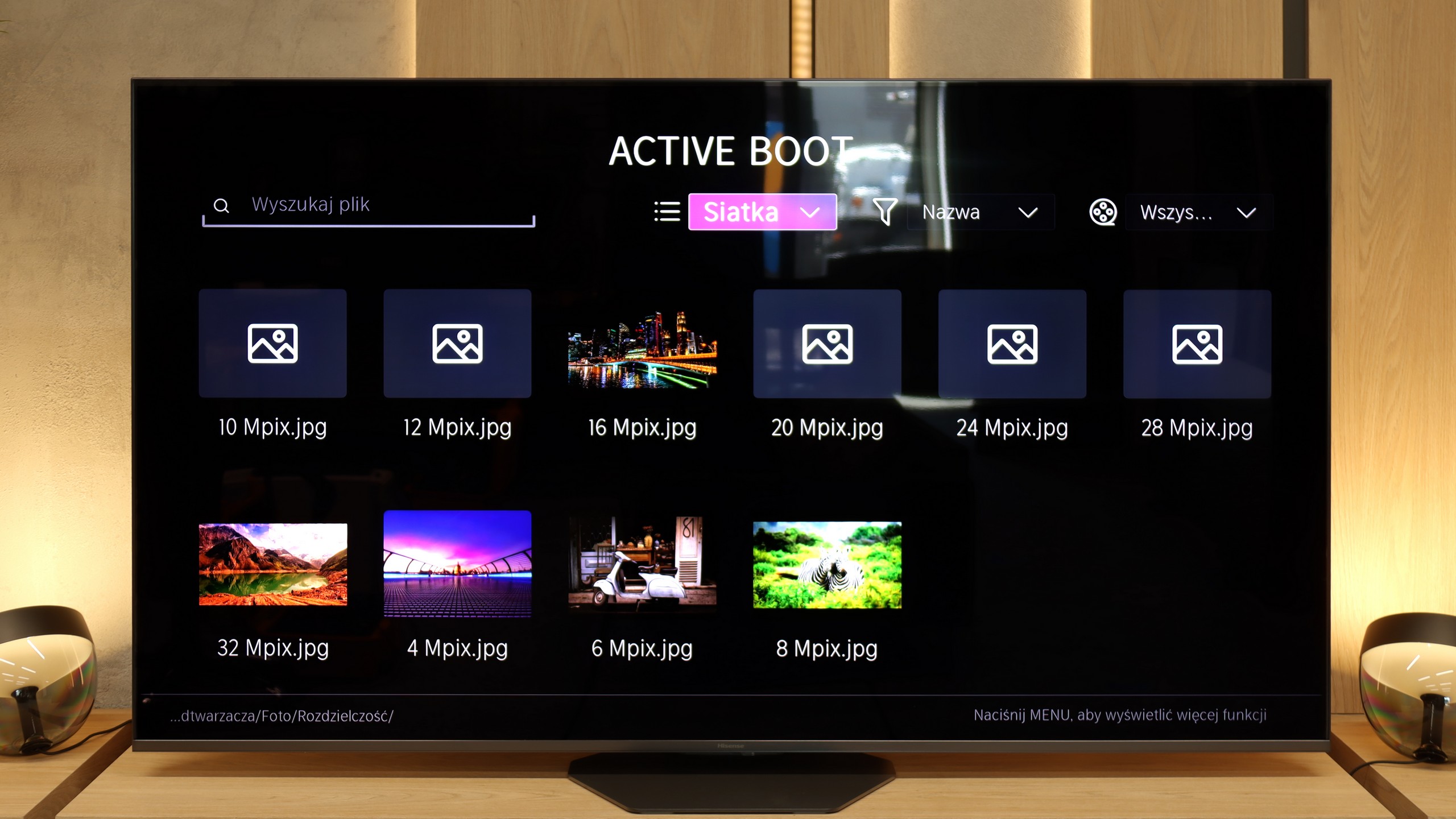

The built-in media player in the Hisense U8Q will be more than sufficient for most people. The television opens popular video and audio formats and also handles photos. However, there is a small caveat – not all photo resolutions are supported. Therefore, if we have photographs saved in a very high number of megapixels, they may simply not open. It is worth keeping this in mind to avoid unpleasant surprises during the family photo presentation.
The built-in media player in the Philips OLED770 works quite well, especially when it comes to subtitles – practically every format we tried was handled correctly, which will certainly please those watching films from their own library. However, there are some reservations regarding photo support. Not all resolutions are recognised, which may surprise users accustomed to viewing photographs from classic cameras or older memory cards. Other than that, everything works properly – it’s just worth ensuring that the television can manage the files we actually want to play on it.
Apps
7.7/10
6.7/10














































Sound
7.8/10
7/10
- Maximum volume88dB80dB
- Dolby Digital Plus 7.1
- Dolby True HD 7.1
- Dolby Atmos in Dolby Digital Plus (JOC)
- Dolby Atmos in Dolby True HD
- DTS:X in DTS-HD MA
- DTS-HD Master Audio
The Hisense U8Q performs really well in terms of sound. The sound quality is pleasant, with a slight bass and quite decent mid-tones, making it entirely sufficient for everyday viewing of films, series, or gaming.
It gets a bit worse when we crank the volume up to 100%. This is rather a rare scenario, but it’s worth mentioning. With very strong bass, the rear speakers start to work so intensely that the television can slightly 'shudder', and the sound transitions into an unpleasant, plastic echo. Therefore, it’s best to stay within the range of 70–80% volume – at that level, the U8Q sounds clear and pleasant, without any unwanted effects.
In terms of sound, the Philips OLED770 performs quite well, although one shouldn’t expect strong bass. For regular television watching, streaming services, or series, its capabilities are fully sufficient – dialogues are clear, and the overall tonal balance is at a decent level. However, when we want to feel a real impact in cinematic productions or games, it quickly becomes apparent that there is a lack of solid low-end frequencies. In such a situation, a natural complement is an additional soundbar or audio system that allows you to make the most of the excellent picture.
On the plus side, versatility in handling formats is noteworthy. The OLED770 handles practically all popular codecs, including Dolby Atmos, DTS:X, and Dolby TrueHD. This means that when connecting external audio equipment, you can expect a full audio experience, even if the built-in speakers in the television do not create a spectacular impression.
Acoustic Measurements
88dBC (Max)
75dBC
80dBC (Max)
75dBC


